Modelling Farm Growth and Its Impact on Agricultural Land Use: A Country Scale Application of an Agent-Based Model
Abstract
:1. Introduction
2. Description of the ADAM Model Framework
3. A Case Study for Belgium
3.1. Study Area Background
3.2. Data
4. Model Initialisation and Calibration
4.1. Initialisation
4.2. Model Calibration
5. Results and Discussion
5.1. Validation
5.2. Simulations of a Business-as-Usual Scenario Until 2030
5.3. Discussion
6. Conclusions
Supplementary Materials
Author Contributions
Funding
Acknowledgments
Conflicts of Interest
Model Information
References
- Anderson, K. Globalization’s effects on world agricultural trade, 1960–2050. Philos. Trans. R. Soc. B Biol. Sci. 2010, 365, 3007–3021. [Google Scholar] [CrossRef] [PubMed]
- FAO. The State of Food and Agriculture 2000—Lessons from the Past 50 Years; FAO: Rome, Italy, 2000; ISBN 9251044007. [Google Scholar]
- Altieri, M. Ecological impacts of industrial agriculture and the possibilities for truly sustainable farming. Mon. Rev. N. Y. 1998, 50, 60–71. [Google Scholar] [CrossRef]
- Van Hecke, E.; Antrop, M.; Schmitz, S.; Sevenant, M.; Van Eetvelde, V. Atlas van België—2 Landschap, Platteland en Landbouw; Academia Press: Gent, Belgium, 2010. [Google Scholar]
- Mather, A.S.; Fairbairn, J.; Needle, C.L. The course and drivers of the forest transition: The case of France. J. Rural Stud. 1999, 15, 65–90. [Google Scholar] [CrossRef]
- The World Bank. Agriculture for Development; The World Bank: Washington, DC, USA, 2008; Volume 54, ISBN 9780821368077. [Google Scholar]
- United States Department of Agriculture (USDA). National Agricultural Statistics Service Farms and Land in Farms; USDA: Washington, DC, USA, 2017; Volume 3, pp. 1995–2004.
- European Commission Small and Large Farms in the EU—Statistics from the Farm Structure Survey—Statistics Explained. Available online: http://ec.europa.eu/eurostat/statistics-explained/index.php/Small_and_large_farms_in_the_EU_-_statistics_from_the_farm_structure_survey (accessed on 2 October 2017).
- D’Odorico, P.; Carr, J.A.; Laio, F.; Ridolfi, L.; Vandoni, S. Feeding humanity through global food trade Earth’ s Future. Earth’s Future 2014, 2, 458–469. [Google Scholar] [CrossRef]
- Van Hecke, E. Revenus et Pauvreté dans L’Agriculture Wallonne; Fondation Roi Baudouin: Brussels, Belgium, 2001; ISBN 2-87212-335-0. [Google Scholar]
- Van Hecke, E.; Meert, H.; Christians, C. Belgian agriculture and rural environments. Belgeo 2000, 201–218. [Google Scholar] [CrossRef] [Green Version]
- Meert, H.; Vernimmen, T.; Bourgeois, M.; Van Huylenbroeck, G.; Van Hecke, E. Erop of Eronder: Bestaans(on)zekere Boeren en hun Overlevingsstrategieën; Koning Boudewijn Stichting: Brussels, Belgium, 2002; ISBN 90-5130-410-2. [Google Scholar]
- Mazoyer, M.; Roudart, L. A History of World Agriculture: From the Neolithic Age to the Current Crisis; NYU Press: New York, NY, USA, 2006; ISBN 9781844074006. [Google Scholar]
- Harms, W.B.; Stortelder, A.H.F.; Vos, W. Effects of Intensification of Agriculture on Nature and Landscape in the Netherlands. Ekológia 1984, 3, 281–304. [Google Scholar]
- Ihse, M. Swedish agricultural landscapes—Patterns and changes during the last 50 years, studied by aerial photos. Landsc. Urban Plan. 1995, 31, 21–37. [Google Scholar] [CrossRef]
- Poudevigne, I.; Alard, D. Landscape and agricultural patterns in rural areas: A case study in the Brionne Basin, Normandy, France. J. Environ. Manag. 1997, 50, 335–349. [Google Scholar] [CrossRef]
- Björklund, J.; Limburg, K.E.; Rydberg, T. Impact of production intensity on the ability of the agricultural landscape to generate ecosystem services: An example from Sweden. Ecol. Econ. 1999, 29, 269–291. [Google Scholar] [CrossRef]
- Eurostat. Farm Structure Survey 2013; Eurostat: Kirchberg, Luxembourg, 2015; Volume 206. [Google Scholar]
- European Commission. The Common Agricultural Policy; European Commission: Luxembourg, 2012; Volume 24. [Google Scholar]
- USDA. U.S. Farm Policy: The First 200 Years; USDA: Washington, DC, USA, 2002; pp. 21–25.
- Headey, D.D. The evolution of global farming land: Facts and interpretations. Agric. Econ. 2016, 47, 185–196. [Google Scholar] [CrossRef]
- Lerman, Z.; Kislev, Y.; Biton, D.; Kriss, A. Agricultural Output and Productivity in the Former Soviet Republics. Econ. Dev. Cult. Chang. 2003, 51, 999–1018. [Google Scholar] [CrossRef]
- Alston, J.M.; Babcock, B.A.; Pardey, P.G. The Shifting Patterns of Agricultural Production and Productivity Worldwide; Midwest Agribusiness Trade Research and Information Center: Ames, IA, USA, 2010; ISBN 978-0-9624121-8-9. [Google Scholar]
- Beddow, J.M.; Pardey, P.G. Moving Matters: The Effect of Location on Crop Production. J. Econ. Hist. 2015, 75, 219–249. [Google Scholar] [CrossRef]
- Rivers, N.; Schaufele, B. The effect of carbon taxes on agricultural trade. Can. J. Agric. Econ. 2014, 63, 235–257. [Google Scholar] [CrossRef]
- FAO. The Future of Food and Agriculture—Trends and Challenges; FAO: Rome, Italy, 2017. [Google Scholar]
- Westhoek, H.J.; Van Den Berg, M.; Bakkes, J.A. Scenario development to explore the future of Europe’s rural areas. Agric. Ecosyst. Environ. 2006, 114, 7–20. [Google Scholar] [CrossRef]
- Alexandratos, N.; Bruinsma, J. World agriculture: Towards 2015/2030: An FAO perspective. Land Use Policy 2003, 20, 375. [Google Scholar] [CrossRef]
- Spangenberg, J.H.; Fronzek, S.; Hammen, V.; Hickler, T.; Jäger, J.; Jylhä, K.; Kühn, I.; Marion, G.; Maxim, L.; Monterroso, I.; et al. The ALARM Scenarios: Storylines and Simulations for Assessing Biodiversity Risks in Europe. In Atlas Biodivers. Risk; Pensoft: Sofia, Bulgaria, 2010; pp. 10–15. ISBN 9789546424471. [Google Scholar]
- Brown, C.; Murray-Rust, D.; Van Vliet, J.; Alam, S.J.; Verburg, P.H.; Rounsevell, M.D. Experiments in globalisation, food security and land use decision making. PLoS ONE 2014, 9, 1–24. [Google Scholar] [CrossRef] [PubMed] [Green Version]
- Berger, T. Agent-based spatial models applied to agriculture: A simulation tool for technology diffusion, resource use changes and policy analysis. Agric. Econ. 2001, 25, 245–260. [Google Scholar] [CrossRef]
- Parker, D.C.; Berger, T.; Manson, S.M. Agent-Based Models of Land-Use and Land-Cover Change. LUCC Rep. Ser. 2002, 140, 4–7. [Google Scholar]
- Bousquet, F.; Le Page, C. Multi-agent simulations and ecosystem management: A review. Ecol. Modell. 2004, 176, 313–332. [Google Scholar] [CrossRef]
- Parker, D.C.; Manson, S.M.; Berger, T. Potential strengths and appropriate roles for ABM/LUCC. In Proceedings of the Special Workshop on Agent-Based Models of Land-Use/Land-Cover Change (CIPEC/CSISS), Santa Barbara, CA, USA, 4–7 October 2001; pp. 17–24. [Google Scholar]
- Parker, D.C.; Manson, S.M.; Janssen, M.A.; Hoffmann, M.J.; Deadman, P. Multi-Agent Systems for the Simulation of Land-Use and Land-Cover Change: A Review. Ann. Assoc. Am. Geogr. 2002, 75. [Google Scholar] [CrossRef]
- Schelling, T.C. Dynamic models of segregation. J. Math. Sociol. 1971, 1, 143–186. [Google Scholar] [CrossRef]
- Murray-Rust, D.; Brown, C.; van Vliet, J.; Alam, S.J.; Robinson, D.T.; Verburg, P.H.; Rounsevell, M. Combining agent functional types, capitals and services to model land use dynamics. Environ. Model. Softw. 2014, 59, 187–201. [Google Scholar] [CrossRef]
- Murray-Rust, D.; Dendoncker, N.; Dawson, T.P.; Acosta-Michlik, L.; Karali, E.; Guillem, E.; Rounsevell, M. Conceptualising the analysis of socio-ecological systems through ecosystem services and agent-based modelling. J. Land Use Sci. 2011, 6, 83–99. [Google Scholar] [CrossRef]
- Bakker, M.M.; Jamal, S.; Van Dijk, J.; Rounsevell, M.D.A. Land-use change arising from rural land exchange: An agent-based simulation model. Landsc. Ecol. 2015, 30, 273–286. [Google Scholar] [CrossRef]
- Grimm, V.; Berger, U.; Bastiansen, F.; Eliassen, S.; Ginot, V.; Giske, J.; Goss-Custard, J.; Grand, T.; Heinz, S.K.; Huse, G.; et al. A standard protocol for describing individual-based and agent-based models. Ecol. Modell. 2006, 198, 115–126. [Google Scholar] [CrossRef]
- Grimm, V.; Berger, U.; DeAngelis, D.L.; Polhill, J.G.; Giske, J.; Railsback, S.F. The ODD protocol: A review and first update. Ecol. Modell. 2010, 221, 2760–2768. [Google Scholar] [CrossRef] [Green Version]
- Bert, F.E.; Podestá, G.P.; Rovere, S.L.; Menéndez, Á.N.; North, M.; Tatara, E.; Laciana, C.E.; Weber, E.; Toranzo, F.R. An agent based model to simulate structural and land use changes in agricultural systems of the argentine pampas. Ecol. Modell. 2011, 222, 3486–3499. [Google Scholar] [CrossRef]
- Yamashita, R.; Hoshino, S. Development of an agent-based model for estimation of agricultural land preservation in rural Japan. Agric. Syst. 2018, 164, 264–276. [Google Scholar] [CrossRef]
- Rounsevell, M.D.A.; Annetts, J.E.; Audsley, E.; Mayr, T.; Reginster, I. Modelling the spatial distribution of agricultural land use at the regional scale. Agric. Ecosyst. Environ. 2003, 95, 465–479. [Google Scholar] [CrossRef]
- Karali, E.; Brunner, B.; Doherty, R.; Hersperger, A.M.; Rounsevell, M.D.A. The Effect of Farmer Attitudes and Objectives on the Heterogeneity of Farm Attributes and Management in Switzerland. Hum. Ecol. 2013, 41, 915–926. [Google Scholar] [CrossRef]
- Karali, E.; Brunner, B.; Doherty, R.; Hersperger, A.; Rounsevell, M. Identifying the Factors That Influence Farmer Participation in Environmental Management Practices in Switzerland. Hum. Ecol. 2014, 42, 951–963. [Google Scholar] [CrossRef]
- Büttner, G.; Soukup, T.; Kosztra, B. Addendum to CLC2006 Technical Guidelines; Copernicus Land Monitoring Service: Malaga, Spain, 2014; Volume 2, pp. 1–35. [Google Scholar]
- Mathijs, E.; Relaes, J. Landbouw en Voedsel, Verrassend Actueel; Acco: Leuven, Belgium, 2012; ISBN 9033480956. [Google Scholar]
- European Council. Reform of the Common Agriculturla Policy. Available online: http://www.consilium.europa.eu/en/policies/cap-reform/ (accessed on 6 September 2018).
- European Commission. EU Budget: The Common Agricultural Policy beyond 2020. Available online: http://europa.eu/rapid/press-release_IP-18-3985_en.htm (accessed on 6 September 2018).
- Olesen, J.E.; Bindi, M. Consequences of climate change for European agricultural productivity, land use and policy. Eur. J. Agron. 2002, 16, 239–262. [Google Scholar] [CrossRef]
- Maertens, E. Agromilieumaatregelen: Hoe Denken Landbouwers Erover? Departement Landbouw en Visserij: Brussels, Belgium, 2011. [Google Scholar]
- Van Passel, S.; Massetti, E.; Mendelsohn, R. A Ricardian Analysis of the Impact of Climate Change on European Agriculture. Environ. Resour. Econ. 2017, 67, 725–760. [Google Scholar] [CrossRef]
- Statistics Belgium. Agricultural Surveys from 1980–2015; Statistics Belgium: Brussels, Belgium, 2015.
- European Commission. Integrated Administration and Control System (IACS). Available online: https://ec.europa.eu/agriculture/direct-support/iacs_en (accessed on 6 September 2018).
- Food and Agriculture Organization Producer Prices—Annual. Available online: http://www.fao.org/faostat/en/#data/PP (accessed on 3 June 2018).
- Van Vliet, J.; de Groot, H.L.F.; Rietveld, P.; Verburg, P.H. Manifestations and underlying drivers of agricultural land use change in Europe. Landsc. Urban Plan. 2015, 133, 24–36. [Google Scholar] [CrossRef]
- Poelmans, L.; Van Rompaey, A. Detecting and modelling spatial patterns of urban sprawl in highly fragmented areas: A case study in the Flanders-Brussels region. Landsc. Urban Plan. 2009, 93, 10–19. [Google Scholar] [CrossRef]
- Mustafa, A.; Van Rompaey, A.; Cools, M.; Saadi, I.; Teller, J. Addressing the determinants of built-up expansion and densification processes at the regional scale. Urban Stud. 2018, 0042098017749176. [Google Scholar] [CrossRef]
- Mollen, F.H. Beton Rapport van de Vlaamse Gemeenten en Provincies; Natuurpunt: Mechelen, Belgium, 2018. [Google Scholar]
- Bouchedor, A. Pressions sur nos Terres Agricoles; FIAN Belgium: Brussels, Belgium, 2017. [Google Scholar]
- Departement Landbouw en Visserij. Landbouwrapport 2014; Departement Landbouw en Visserij: Brussels, Belgium, 2014. [Google Scholar]
- Delbecq, B.A.; Florax, R. Farmland allocation along the rural-urban gradient: The impacts of urbanization and urban sprawl. In Proceedings of the Agricultural and Applied Economics Association 2010 Annual Meeting, Denver, CO, USA, 25–27 July 2010; pp. 25–27. [Google Scholar]
- Marshall, E.J.P.; Moonen, A.C. Field margins in northern Europe: Their functions and interactions with agriculture. Agric. Ecosyst. Environ. 2002, 89, 5–21. [Google Scholar] [CrossRef]
- Stoate, C.; Boatman, N.D.; Borralho, R.J.; Carvalho, C.R.; de Snoo, G.R.; Eden, P. Ecological impacts of arable intensification in Europe. J. Environ. Manag. 2001, 63, 337–365. [Google Scholar] [CrossRef]
- Benton, T.G.; Vickery, J.A.; Wilson, J.D. Farmland biodiversity: Is habitat heterogeneity the key? Trends Ecol. Evol. 2003, 18, 182–188. [Google Scholar] [CrossRef]
- Danckaert, S.; Cazaux, G.; Bas, L.; Van Gijseghem, D. Landbouw in een Groen en Dynamisch Stedengewest; Departement Landbouw en Visserij, afdeling Monitoring en Studie: Brussel, Belgium, 2010; Volume 66. [Google Scholar]
- Fontaine, C.M.; Rounsevell, M.D.A. An Agent-based approach to model future residential pressure on a regional landscape. Landsc. Ecol. 2009, 24, 1237–1254. [Google Scholar] [CrossRef]
- Verburg, P.H.; Soepboer, W.; Veldkamp, A.; Limpiada, R.; Espaldon, V.; Mastura, S.S.A. Modeling the spatial dynamics of regional land use: The CLUE-S model. Environ. Manag. 2002, 30, 391–405. [Google Scholar] [CrossRef] [PubMed]
- De Lauwere, C.C. The role of agricultural entrepreneurship in Dutch agriculture of today. Agric. Econ. 2005, 33, 229–238. [Google Scholar] [CrossRef]
- Van Vliet, J.; Magliocca, N.R.; Büchner, B.; Cook, E.; Rey Benayas, J.M.; Ellis, E.C.; Heinimann, A.; Keys, E.; Lee, T.M.; Liu, J.; et al. Meta-studies in land use science: Current coverage and prospects. Ambio 2016, 45, 15–28. [Google Scholar] [CrossRef] [PubMed] [Green Version]
- Veldkamp, A.; Fresco, L.O. CLUE: A conceptual model to study the Conversion of Land Use and its Effects. Ecol. Modell. 1996, 85, 253–270. [Google Scholar] [CrossRef]
- Verburg, P.H.; Overmars, K.P. Combining top-down and bottom-up dynamics in land use modeling: Exploring the future of abandoned farmlands in Europe with the Dyna-CLUE model. Landsc. Ecol. 2009, 24, 1167–1181. [Google Scholar] [CrossRef]
- Sohl, T.; Sayler, K. Using the FORE-SCE model to project land-cover change in the southeastern United States. Ecol. Modell. 2008, 219, 49–65. [Google Scholar] [CrossRef]
- Soares-Filho, B.S.; Coutinho Cerqueira, G.; Lopes Pennachin, C. DINAMICA—A stochastic cellular automata model designed to simulate the landscape dynamics in an Amazonian colonization frontier. Ecol. Modell. 2002, 154, 217–235. [Google Scholar] [CrossRef]
- Thornton, P.K.; Jones, P.G. A conceptual approach to dynamic agricultural land-use modelling. Agric. Syst. 1998, 57, 505–521. [Google Scholar] [CrossRef]
- Schaldach, R.; Alcamo, J.; Koch, J.; Kölking, C.; Lapola, D.M.; Schüngel, J.; Priess, J.A. An integrated approach to modelling land-use change on continental and global scales. Environ. Model. Softw. 2011, 26, 1041–1051. [Google Scholar] [CrossRef]
- Van Meijl, H.; Van Rheenen, T.; Tabeau, A.; Eickhout, B. The impact of different policy environments on agricultural land use in Europe. Agric. Ecosyst. Environ. 2006, 114, 21–38. [Google Scholar] [CrossRef]
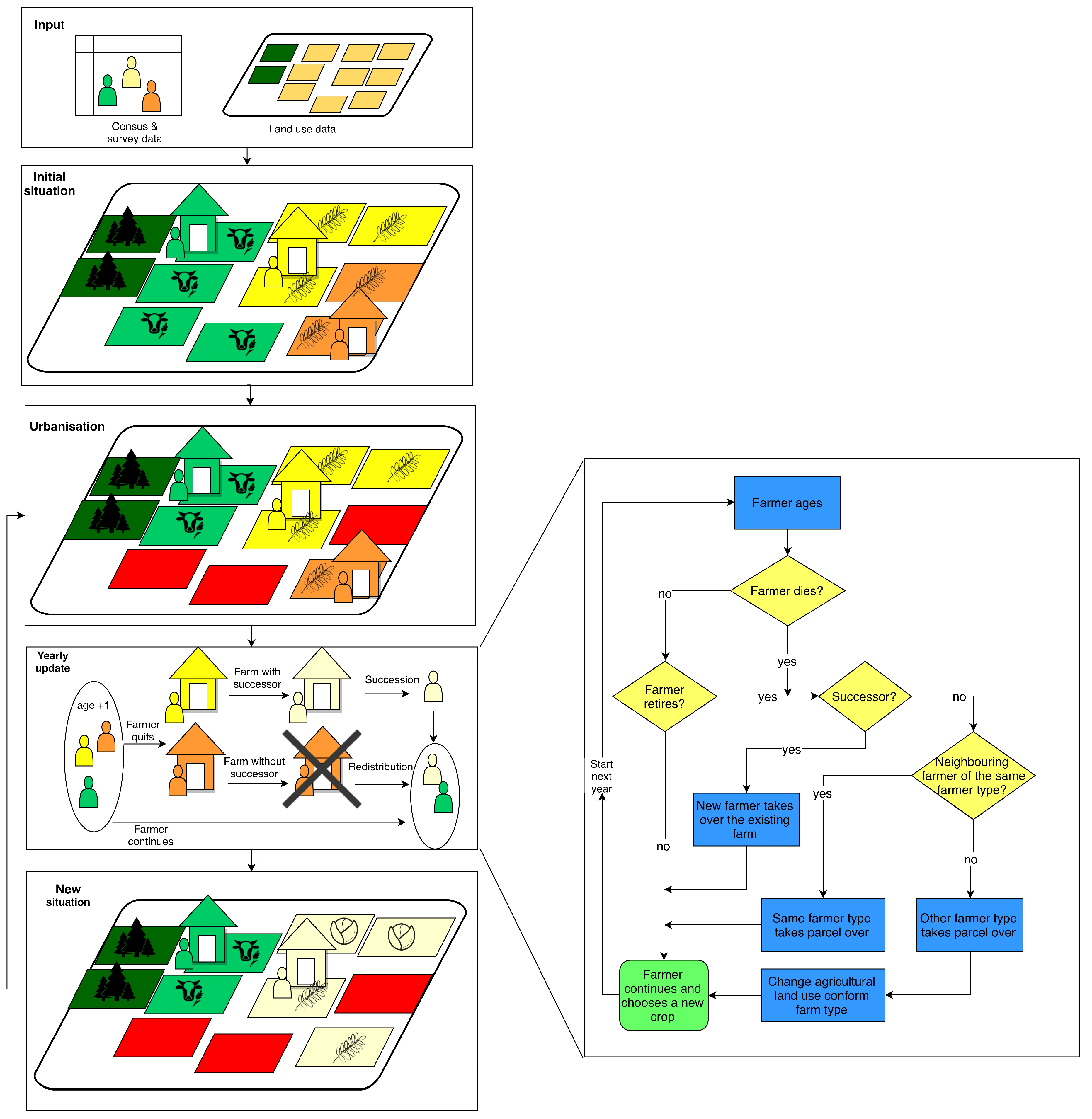
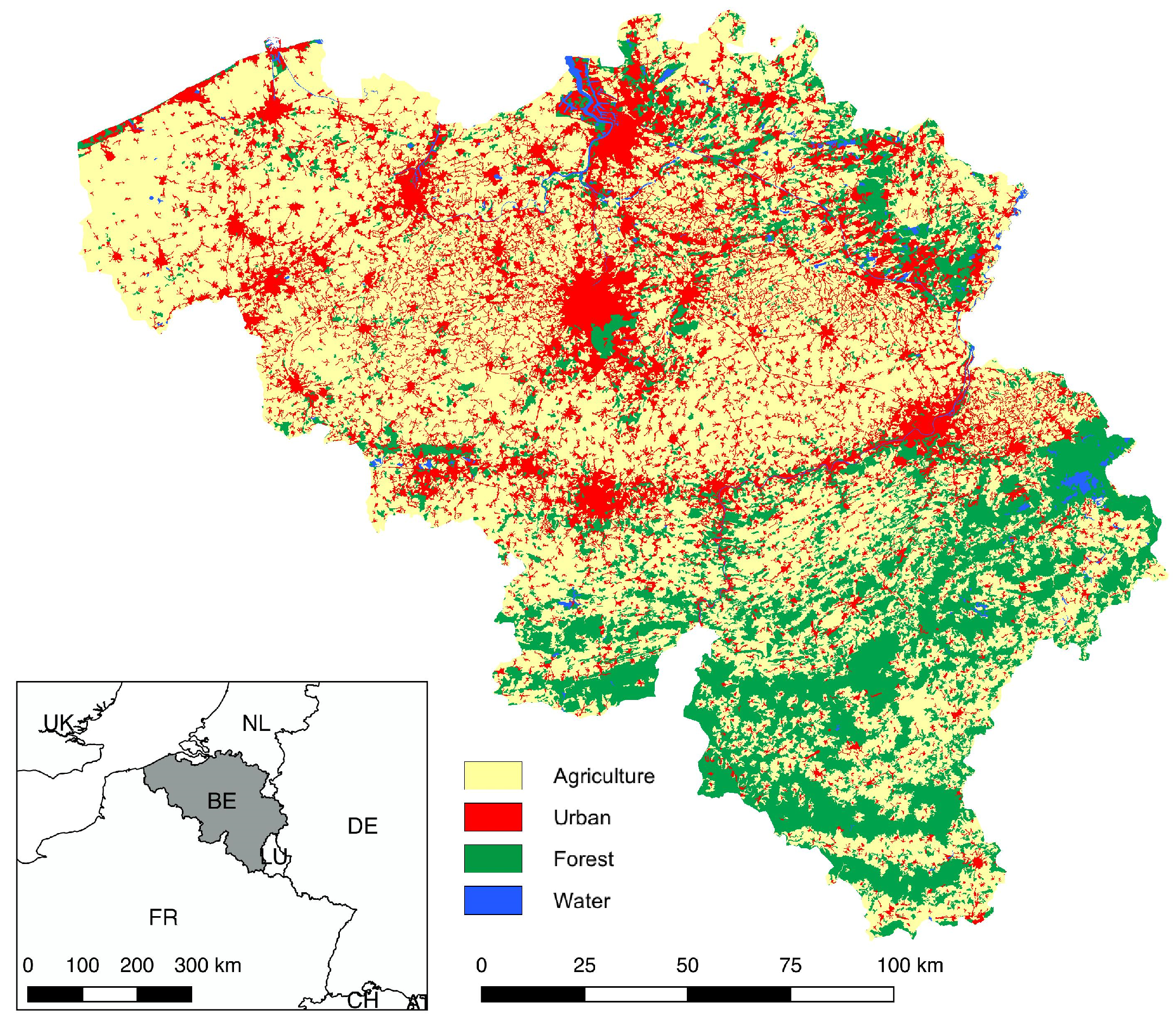

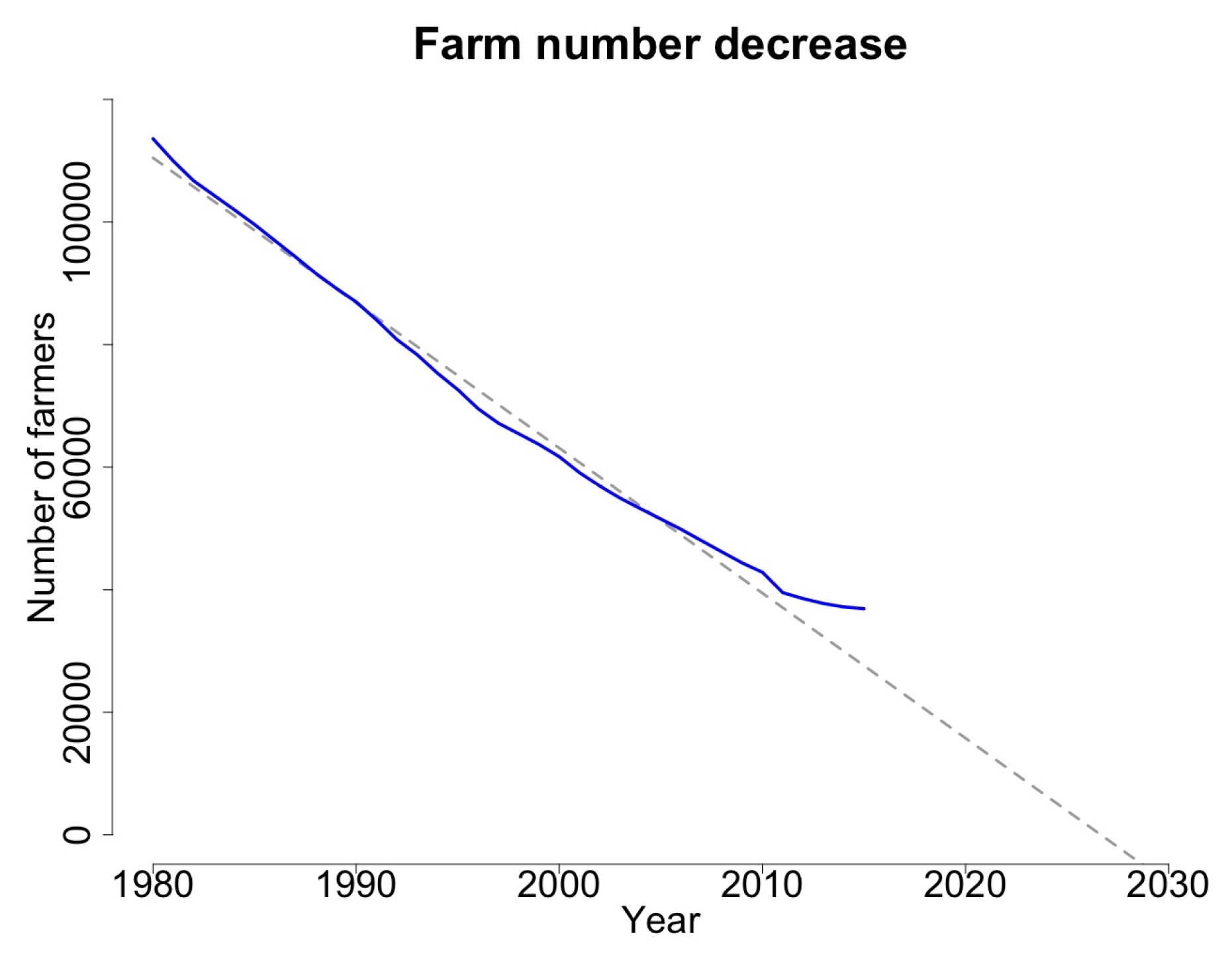
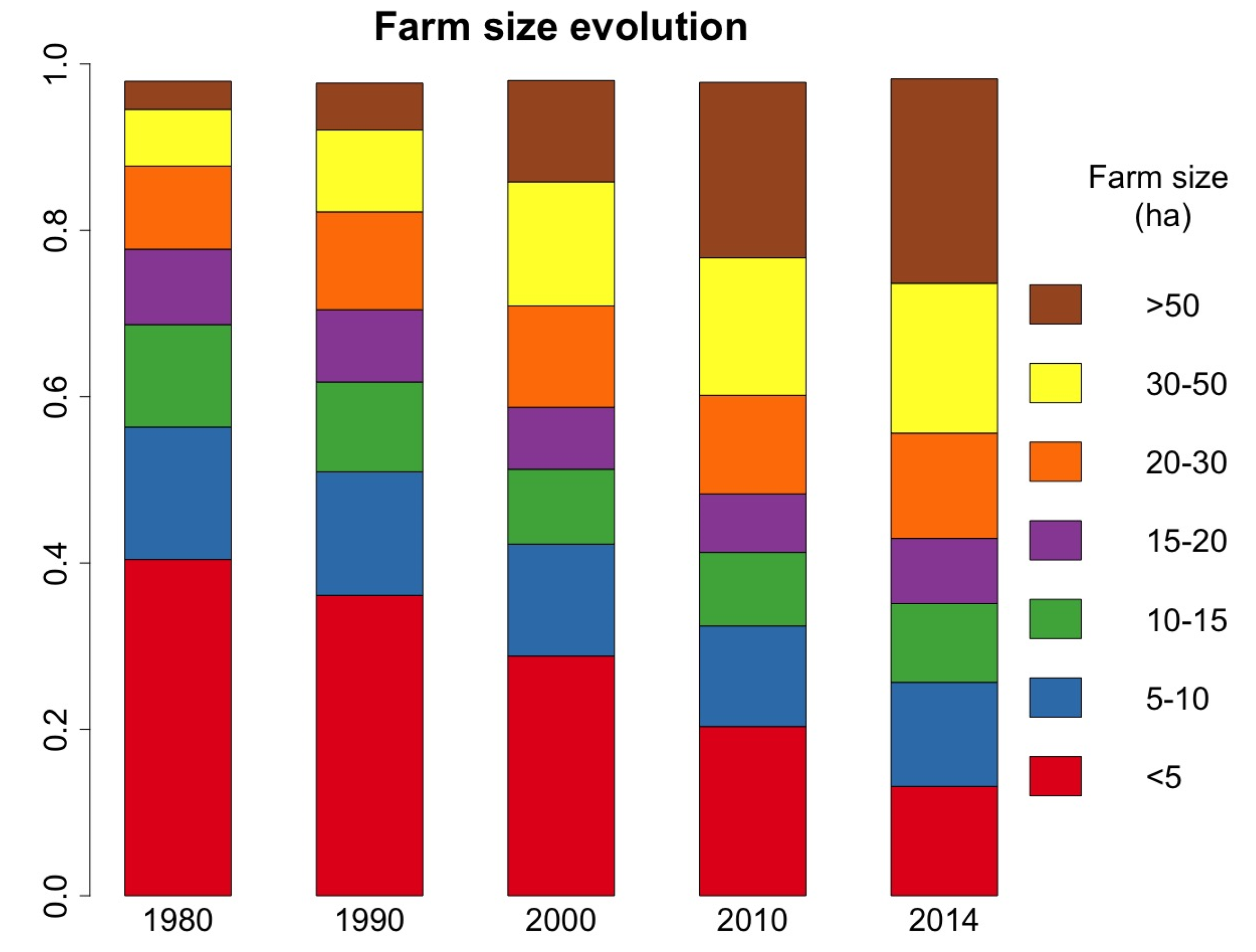



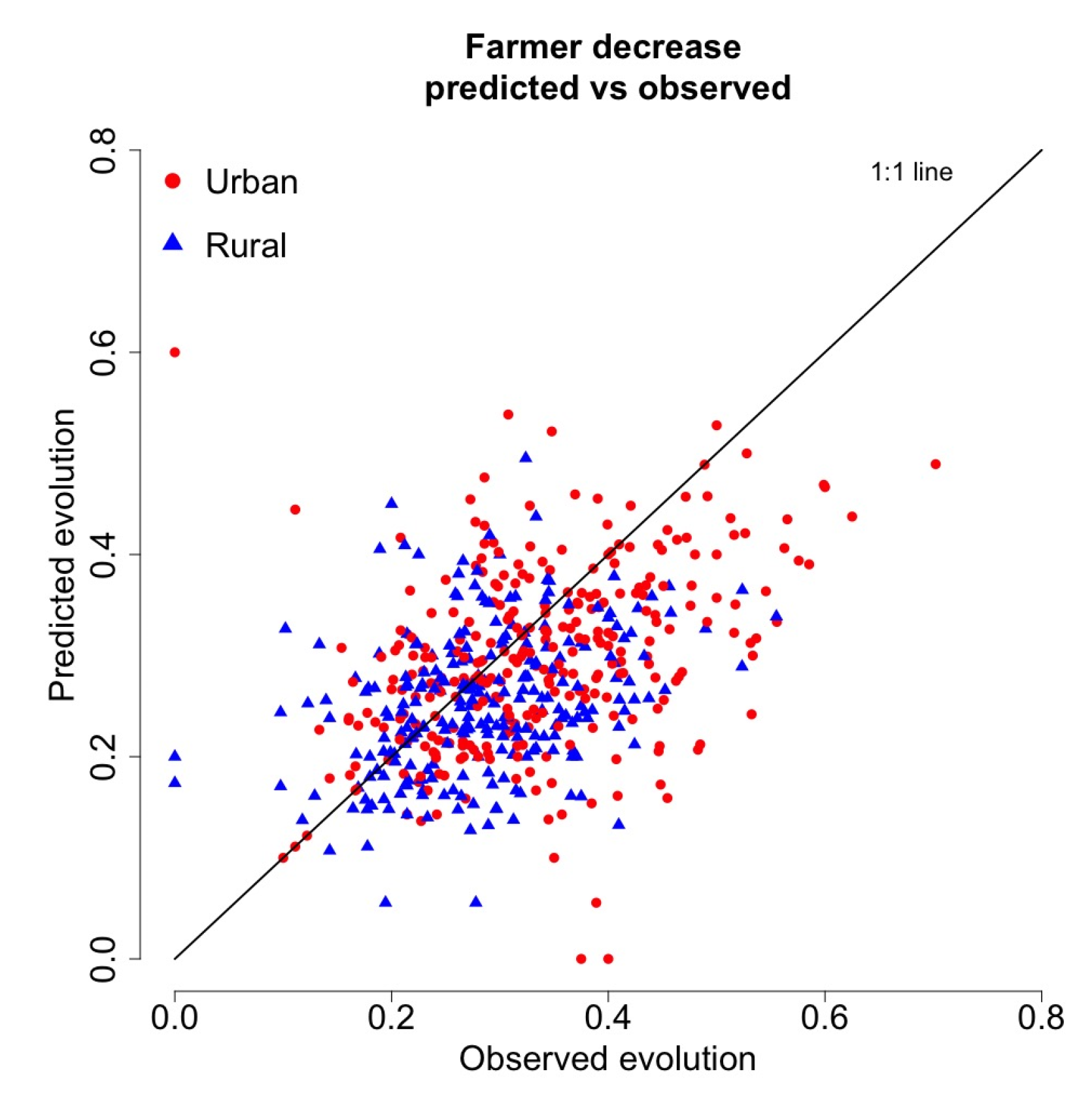
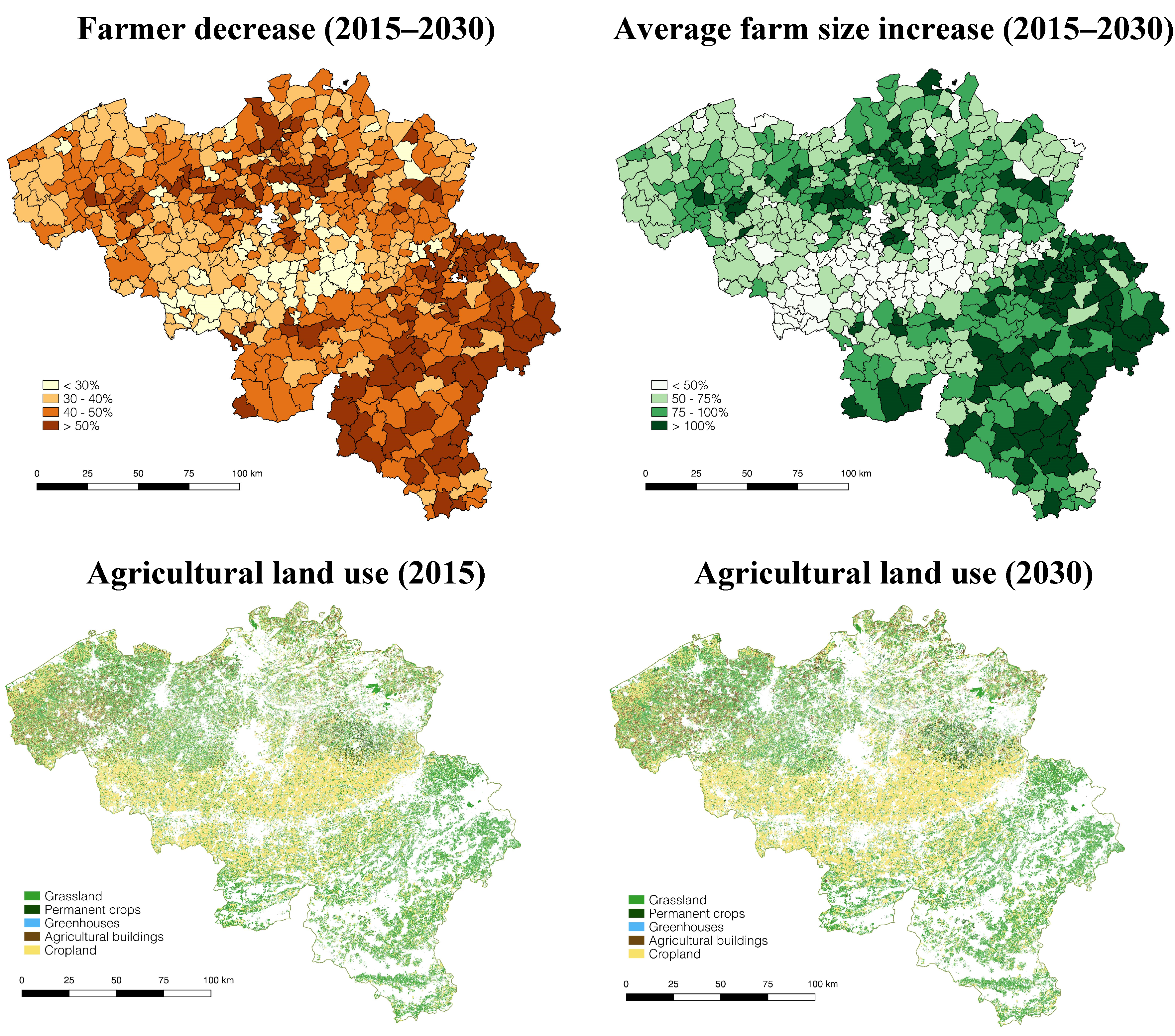
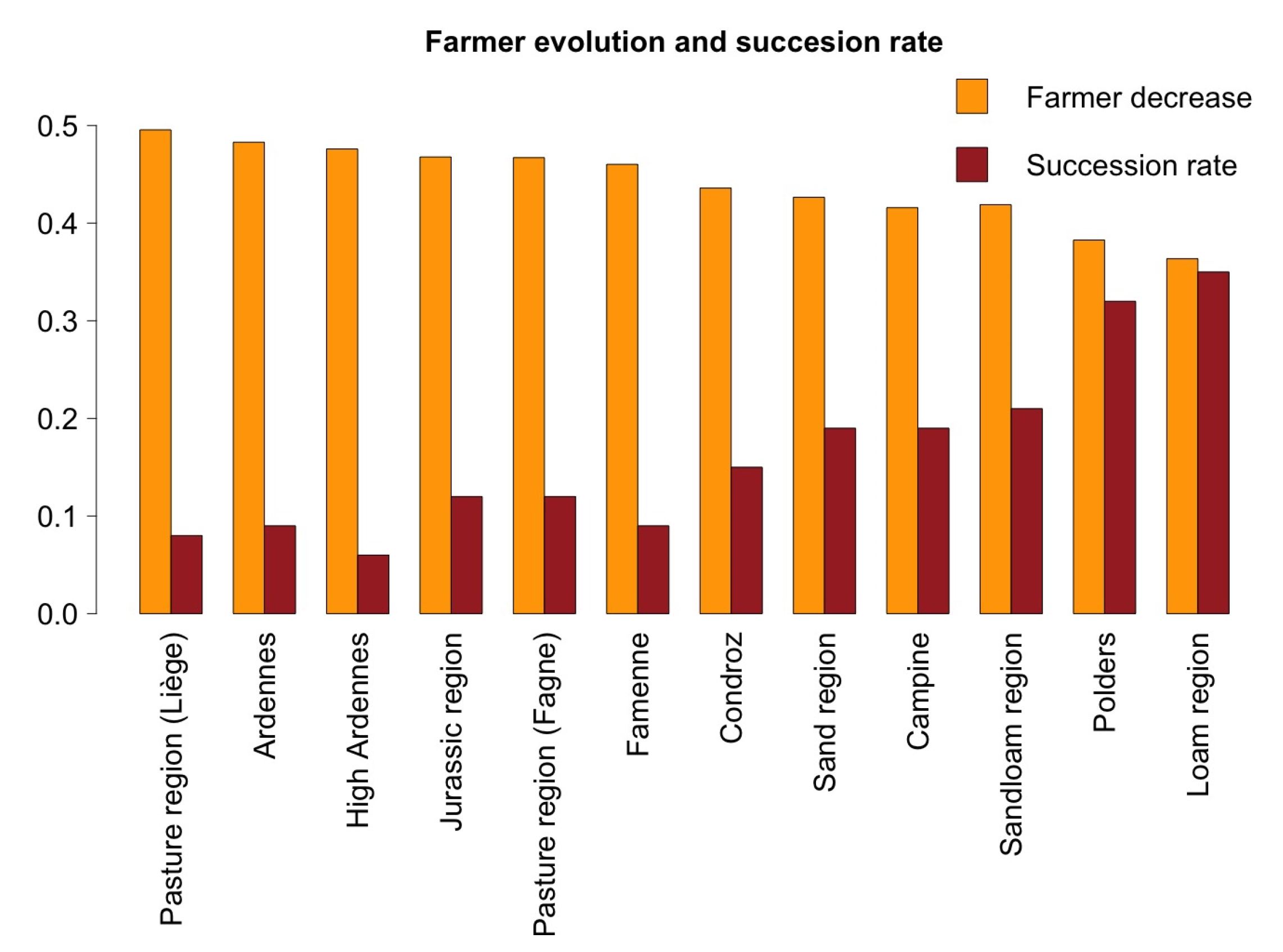
| Variable | Variable Type | Update |
|---|---|---|
| Farm type | Categorical variable related to the type of farming practice | Farm type can change when new farmer takes over |
| Age of farmer | Numerical variable | Yearly update, changes when farmer is succeeded |
| Parcel | Geographical variable (polygon with location and size) | Farmer and type (agricultural land use) can change if parcels are taken over |
| Farm size | Numerical: sum of size of parcels farmed by a farmer | Increases when farmer takes over other parcels |
| Farm Type | Main Parcel Type | Common Agricultural Product |
|---|---|---|
| Yearly rotating crop farmers | Arable land with temporary crops | Wheat, barley, maize, beets, potatoes, rapeseed |
| Greenhouse farmers | Greenhouses | Tomatoes, bell peppers, cucumbers, zucchinis, strawberries, flowers |
| Barn based animal farmer | Barns and cropland | Meat (pork & poultry) & eggs |
| Land based animal farmer | Barns, grassland, and cropland | Meat (beef), milk |
| Permanent crop farmers | Arable land with permanent crops | Apples, pears, cherries |
| Profitability > (μ + SD * 2.5) | ➔ | P(succ) = regionalSurvChance * 4 |
| Profitability > (μ + SD * 1.5) | ➔ | P(succ) = regionalSurvChance * 3 |
| Profitability > (μ + SD * 0.5) | ➔ | P(succ) = regionalSurvChance * 2 |
| Profitability > (μ − SD * 0.5) | ➔ | P(succ) = regionalSurvChance * 1 |
| Profitability > (μ − SD * 0.75) | ➔ | P(succ) = regionalSurvChance * 0.5 |
| Profitability < (μ − SD * 0.75) | ➔ | P(succ) = regionalSurvChance * 0.1 |
© 2018 by the authors. Licensee MDPI, Basel, Switzerland. This article is an open access article distributed under the terms and conditions of the Creative Commons Attribution (CC BY) license (http://creativecommons.org/licenses/by/4.0/).
Share and Cite
Beckers, V.; Beckers, J.; Vanmaercke, M.; Van Hecke, E.; Van Rompaey, A.; Dendoncker, N. Modelling Farm Growth and Its Impact on Agricultural Land Use: A Country Scale Application of an Agent-Based Model. Land 2018, 7, 109. https://doi.org/10.3390/land7030109
Beckers V, Beckers J, Vanmaercke M, Van Hecke E, Van Rompaey A, Dendoncker N. Modelling Farm Growth and Its Impact on Agricultural Land Use: A Country Scale Application of an Agent-Based Model. Land. 2018; 7(3):109. https://doi.org/10.3390/land7030109
Chicago/Turabian StyleBeckers, Veronique, Jeroen Beckers, Matthias Vanmaercke, Etienne Van Hecke, Anton Van Rompaey, and Nicolas Dendoncker. 2018. "Modelling Farm Growth and Its Impact on Agricultural Land Use: A Country Scale Application of an Agent-Based Model" Land 7, no. 3: 109. https://doi.org/10.3390/land7030109





